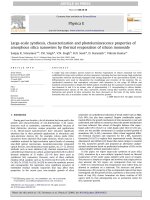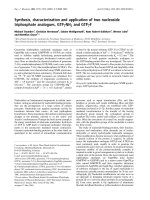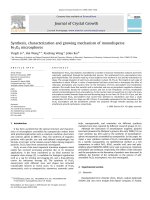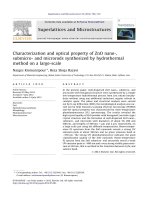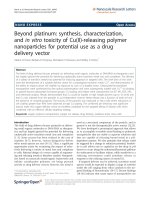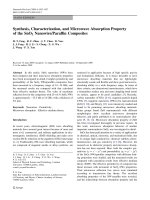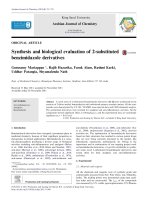Green synthesis, characterization and antimicrobial evaluation of nano silver on mastitis causing microorganisms
Bạn đang xem bản rút gọn của tài liệu. Xem và tải ngay bản đầy đủ của tài liệu tại đây (205.76 KB, 5 trang )
Int.J.Curr.Microbiol.App.Sci (2019) 8(10): 1891-1895
International Journal of Current Microbiology and Applied Sciences
ISSN: 2319-7706 Volume 8 Number 10 (2019)
Journal homepage:
Original Research Article
/>
Green Synthesis, Characterization and Antimicrobial Evaluation of
Nano Silver on Mastitis Causing Microorganisms
Adyasha Debata, Kamdev Sethy*, D. Jena, S. Pati and B. Saisandeep
Odisha University of Agriculture and Technology, Bhubaneshwar,
Odisha, India -751003
*Corresponding author
ABSTRACT
Keywords
Bacteria, Mastitis,
Nanotechnology,
Silver
Article Info
Accepted:
15 September 2019
Available Online:
10 October 2019
Nanotechnology is now creating a growing sense of excitement in the field of life science.
Nano particles can be synthesized by physical and chemical method but green synthesis
method is the most emerging approach of preparation due to eco friendly and less time
consuming procedure. This study aimed at green synthesis, characterization and evaluation
of antibacterial effect of nano silver on mastitis causing bacteria. Aqueous coriander leaf
extract with certain concentration of reducing agent were used for the production of silver
nano particles. Characterization of synthesized silver nano particles was done by Zeta sizer
analysis. The result of zeta sizer analysis reveals that the diameters of nano particles are
within the range of nano scale. Transmission electron microscopy (TEM) analysis of silver
nano particles was done to confirm the shape, size and morphology. Antibacterial activity
of nano silver was investigated on mastitis causing bacteria such as E. coli, P. aeruginosa,
S. aureus by well diffusion method. The antibiosis test result indicated that silver nano
particles are able to inhibit E. coli and S. aureus but unable to inhibit P. aeruginosa.
Therefore green synthesized nano silver can be used as anti microbial agent for mastitis
causing bacteria.
Introduction
A nano material is defined as elements having
at least one dimension in length, ranges
between 1 nm and 100 nm. Nano particles
(NPs) have wide range of applications in areas
such as health care, cosmetics, food and feed,
environmental health, mechanics, optics,
biomedical sciences, chemical industries,
electronics and space industries (Nel et al.,
2006). NPs can be synthesized using various
approaches including chemical, physical, and
biological. Although chemical method of
synthesis requires short period of time for
synthesis of large quantity of NPs, the
chemicals used are toxic and lead to non- eco
friendly by products. Thus, there is an
increasing demand for green synthesis of NPs
(Dietz and Herth, 2011).
Green synthesis approaches include mixedvalence polyoxometalates, polysaccharides,
tollens, biological, and irradiation method
which have advantages over conventional
1891
Int.J.Curr.Microbiol.App.Sci (2019) 8(10): 1891-1895
methods involving chemical agents associated
with environmental toxicity. Among plants,
Coriandrum sativum are easily available and
has been used in synthesis of various nano
particles. Silver (Ag) nano particles have been
widely used as an effective antimicrobial
agent against bacteria, fungi, and viruses (Aziz
et al., 2015). Their effect was recognized
already in ancient times. Ag and its
compounds have long been used for the
disinfection of medical devices and water
purification. In medicine, Ag compounds are
commonly applied to treat burns, wounds, and
a variety of infectious diseases ((Aziz et al.,
2015). Considering the advantages of green
synthesis, the present investigation was aimed
at production of silver nano particles. Its
characterization by TEM and its effect on
mastitis
causing
microorganisms
like
Staphylococcus aureus, Escherichia coli and
Pseudomonas aeruginosa.
Materials and Methods
Green synthesis of
Coriandrum sativum
AgNps
by
using
Leaf extract of Coriandrum sativum was
prepared by boiling chopped coriander leaves
with distilled water. 50ml of 1mili molar silver
nitrate (AgNO3) solution was prepared by
taking 50 ml distilled water with 0.016gm
silver nitrate. Prepared plant extract were
added at different concentration to the AgNO3
solution. This setup was incubated in a dark
chamber to minimize photo-activation of
silver nitrate at room temperature. Reduction
of AgNO3 was observed on the basis of colour
change from green to reddish brown (Ahmed
et al., 2015) (Fig. 1).
Characterization of AgNps
TEM analysis was performed to determine the
shape and size of synthesized nanoparticles.
NPs samples were diluted in ependroff tubes
using double distilled water and placed in an
ultrasonic bath for 15 minutes. After that one
drop of NPs samples were placed over a
copper grid and leave for overnight drying and
finally observed under TEM (JEOL-2010).
Collection of bacterial pathogens
Mastitis causing microorganisms likes
staphylococcus aureus (S. aureus) (MTCC1144), Escherichia coli (E. coli) (MTCC-443),
Pseudomonas aeruginosa (MTCC-1019) were
obtained from Institute of Microbial
Technology (IMTECH) Chandigarh, India
Evaluation of antibacterial activity of
AgNPs
Antibacterial effect was observed on mastitis
causing microorganisms like S. aureus, P.
aeruginosa, E. coli by well diffusion method.
Mueller Hinton agar medium (Hi-media) was
prepared for lawn culture of the supplied
microorganisms. Then by using a puncher
well diffusion method was done by adding
50µl plant extract solution as control.
Synthesized nano particle solution in same
amount also added to each culture plate.
Incubation was done at 37ºC for 24 hour.
Antibacterial activity was measured on the
basis of the inhibition zone around the well.
Results and Discussion
The first indicator of synthesis of AgNPs
using C. sativum leaf extract in the form of
greenish and then dark brown coloured
pigment. The change in colour from greenish
to brown confirmed a quick reduction of silver
ions (Ag) to zero valent silver (AgNO3). This
difference in colour could be considered as a
primary evidence of reducing potential of C.
sativum leaf. Plants leaves contain a
substantial number of organic constituents,
like phenolic compounds and various types of
glycosides that help in synthesis of metal nano
particles (Lin et al., 2016) The TEM analysis
result of AgNPs demonstrated that the silver
1892
Int.J.Curr.Microbiol.App.Sci (2019) 8(10): 1891-1895
nano particles are predominantly spherical in
shape. These are well dispersed and
homogenous. The average diameter of AgNPs
was around 40-60nm (Fig. 2). Result indicate
C. sativum synthesized NPs having average
size range bellow 100 nm with spherical in
shape. That denote the quality of the NPs is as
good as synthesized by chemical or biological
process (Zhang et al., 2011; Shirsat et al.,
2015).
The antimicrobial activity of newly
synthesized AgNPs was assessed against
mastitis causing bacterial pathogens (Fig. 3).
Well diffusion method was performed against
mastitis causing bacteria such as E.coli,
S. aureus, P. aeruginosa. Inhibition zone well
observed in case of E. coli and S. aureus but
no inhibition zone was observed against P.
aeruginosa. Results from the present study
demonstrate that the antibacterial activity of
NPs may be due to the generation of reactive
oxygen species (ROS), malondialdehyde
(MDA), and leakage of proteins and sugars in
bacterial cells ((Aziz et al., 2015).
Furthermore, low concentration of silver nano
particles were found to be highly effective in
inducing loss of cell viability in both gram
positive and gram negative bacteria. Ag NPs
at a concentration of 1mM prevent the growth
of mastitis causing bacteria.
Fig.1 Synthesis of silver nano particles by using Coriandrum sativum
1893
Int.J.Curr.Microbiol.App.Sci (2019) 8(10): 1891-1895
Fig.2 Size of the silver nano particles by using TEM
Fig.3 Effect of nano silver infusion on mastitis causing microorganisms
Similarly Ahmed et al., (2015) and Mirzajani
et al., (2011) observed that Ag NPs showed
antibacterial activities against both gram
positive (Staphylococcus aureus) and gram
negative (Escherichia coli).
1894
Int.J.Curr.Microbiol.App.Sci (2019) 8(10): 1891-1895
In conclusion, AgNPs can be synthesized by
using Coriandrum sativum leaves and may be
highly beneficial for prevention of growth of
gram positive (Staphylococcus aureus) and
gram negative (Escherichia coli) bacteria.
References
Ahmed, S., Ahmad, M., Swami, B.L. and
Ikram, S. 2015. Plants Extract Mediated
Synthesis of Silver Nanoparticles for
Antimicrobial Applications: A Green
Expertise. Journal of Advanced
Research. 33: 216-230.
Aziz, N., Faraz, M., Pandey, R., Shakir, M.,
Fatma, T., Varma, A., Barman, I. and
Prasad, R., 2015. Facile algae-derived
route to biogenic silver nanoparticles:
synthesis,
antibacterial,
and
photocatalytic properties. Langmuir. 31
(42):11605–11612.
Dietz, K.J. and Herth, S. 2011. Plant
nanotoxicology. Trends in Plant
Science. 16 (11):582–652. 589.
Lin, D. and Xing, B. 2008. Root uptake and
phytotoxicity of ZnO nanoparticles.
Environmental Science and Technology.
42: 5580–5585
Mirzajani, F., Ghassempour, A., Aliahmadi,
A and Esmaeili,
M.A. 2011.
Antibacterial
effect
of
silver
nanoparticles
on
Staphylococcus
aureus. Research Microbiology. 162:
542–549.
Nel, A., Xia, T., Madler, L. and Li, N. 2006.
Toxic potential of materials at the
nanolevel. Science. 311, 622–627.
Zhang, W., Yao, Y., Sullivan, N. and Chen,
Y. 2011. Modelling the primary size
effects
of
citrate-coated
silver
nanoparticles on their ion release
kinetics. Environmental Science and
Technology. 45: 4422–4428.
How to cite this article:
Adyasha Debata, Kamdev Sethy, D. Jena, S. Pati and Saisandeep, B. 2019. Green Synthesis,
Characterization and Antimicrobial Evaluation of Nano Silver on Mastitis Causing
Microorganisms. Int.J.Curr.Microbiol.App.Sci. 8(10): 1891-1895.
doi: />
1895
